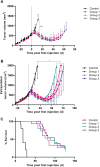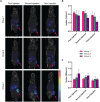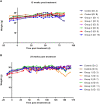The Balance Between the Therapeutic Efficacy and Safety of [177Lu]Lu-NeoB in a Preclinical Prostate Cancer Model
- PMID: 37640941
- PMCID: PMC10828073
- DOI: 10.1007/s11307-023-01851-4
The Balance Between the Therapeutic Efficacy and Safety of [177Lu]Lu-NeoB in a Preclinical Prostate Cancer Model
Abstract
Purpose: Radiolabeled NeoB is a promising gastrin-releasing peptide receptor (GRPR)-targeting radiopharmaceutical for theranostics of GRPR-expressing malignancies, e.g., prostate cancer (PCa). The aim of this study was to evaluate the effect of different doses of [177Lu]Lu-NeoB on the balance between therapeutic efficacy and safety in a preclinical PCa model.
Procedures: To determine the efficacy of [177Lu]Lu-NeoB, PC-3 xenografted mice received 3 sham injections (control group) or 3 injections of 30 MBq/300 pmol, 40 MBq/400 pmol, or 60 MBq/600 pmol [177Lu]Lu-NeoB (groups 1, 2, and 3, respectively) 1 week apart. To quantify tumor uptake, single-photon emission computed tomography/computed tomography (SPECT/CT) imaging was performed 4 h after the first, second, and third injection on a separate group of animals. For safety evaluations, pancreatic and renal tissues of non-tumor-bearing mice treated with the abovementioned [177Lu]Lu-NeoB doses were evaluated 12 and 24 weeks post-treatment.
Results: Treatment of PC-3 tumors with all three studied [177Lu]Lu-NeoB doses was effective. Median survival times were significantly (p < 0.0001) improved for treatment groups 1, 2, and 3 versus the control group (82 days, 89 days, 99 days versus 19 days, respectively). However, no significant differences were observed between treatment groups. Quantification of SPECT/CT images showed minimal differences in the average absolute radioactivity uptake, especially after the third injection. Histopathological analysis revealed no clear signs of treatment-related pancreatic toxicity. For the kidneys, atrophy and fibrosis were observed for one animal from group 1 and a chronic inflammatory response was observed for both animals from group 3 at 24 weeks post-treatment.
Conclusions: Treatment with [177Lu]Lu-NeoB is effective in a preclinical PCa model. Adjusting the administered dose could positively impact the risk-benefit balance as a higher dose might not lead to an increased therapeutic effect, but it may lead to an increase in toxicological effects in healthy organs such as the kidneys.
Keywords: Efficacy; Gastrin-releasing peptide receptor (GRPR); Prostate cancer; Theranostics; Toxicity; [177Lu]Lu-NeoB.
© 2023. The Author(s).
Conflict of interest statement
Financial interests: F.O., D.B. and M.T. are employed by Advanced Accelerator Applications, a Novartis Company. The other authors declare that they have no competing interests.
Figures





Similar articles
-
Safety of [177Lu]Lu-NeoB treatment: a preclinical study characterizing absorbed dose and acute, early, and late organ toxicity.Eur J Nucl Med Mol Imaging. 2022 Nov;49(13):4440-4451. doi: 10.1007/s00259-022-05926-2. Epub 2022 Aug 11. Eur J Nucl Med Mol Imaging. 2022. PMID: 35951084 Free PMC article.
-
Side-by-side comparison of the two widely studied GRPR radiotracers, radiolabeled NeoB and RM2, in a preclinical setting.Eur J Nucl Med Mol Imaging. 2023 Nov;50(13):3851-3861. doi: 10.1007/s00259-023-06364-4. Epub 2023 Aug 16. Eur J Nucl Med Mol Imaging. 2023. PMID: 37584725 Free PMC article.
-
Theranostic Perspectives in Prostate Cancer with the Gastrin-Releasing Peptide Receptor Antagonist NeoBOMB1: Preclinical and First Clinical Results.J Nucl Med. 2017 Jan;58(1):75-80. doi: 10.2967/jnumed.116.178889. Epub 2016 Aug 4. J Nucl Med. 2017. PMID: 27493272
-
Preclinical Development in Radiopharmaceutical Therapy for Prostate Cancer.Semin Nucl Med. 2023 Sep;53(5):663-686. doi: 10.1053/j.semnuclmed.2023.06.007. Epub 2023 Jul 18. Semin Nucl Med. 2023. PMID: 37468417 Review.
-
GRPr Theranostics: Current Status of Imaging and Therapy using GRPr Targeting Radiopharmaceuticals.Nuklearmedizin. 2022 Jun;61(3):247-261. doi: 10.1055/a-1759-4189. Epub 2022 Jun 3. Nuklearmedizin. 2022. PMID: 35668669 Review. English.
Cited by
-
Detection rate of gastrin-releasing peptide receptor (GRPr) targeted tracers for positron emission tomography (PET) imaging in primary prostate cancer: a systematic review and meta-analysis.Ann Nucl Med. 2024 Nov;38(11):865-876. doi: 10.1007/s12149-024-01978-6. Epub 2024 Sep 17. Ann Nucl Med. 2024. PMID: 39287742
-
Evaluation of maSSS/maSES-PEG2-RM26 for their potential therapeutic use after labeling with Re-188. Could their [99mTc]Tc-labeled counterparts be used to estimate dosimetry?EJNMMI Radiopharm Chem. 2025 Jan 17;10(1):3. doi: 10.1186/s41181-024-00326-3. EJNMMI Radiopharm Chem. 2025. PMID: 39825204 Free PMC article.
-
Development of Novel Gastrin-Releasing Peptide Receptor-Targeted Radioligand with Albumin Binder to Improve Accumulation in Tumor.ACS Med Chem Lett. 2025 Apr 25;16(5):797-803. doi: 10.1021/acsmedchemlett.5c00032. eCollection 2025 May 8. ACS Med Chem Lett. 2025. PMID: 40365411
-
RM2 and DB15 analogues bearing [177Lu]Lu-DOTAGA via different linkers, as radiotherapeutics: a head-to-head comparative study.EJNMMI Radiopharm Chem. 2025 Jul 31;10(1):50. doi: 10.1186/s41181-025-00374-3. EJNMMI Radiopharm Chem. 2025. PMID: 40745236 Free PMC article.
References
MeSH terms
Substances
LinkOut - more resources
Full Text Sources
Medical
Miscellaneous

